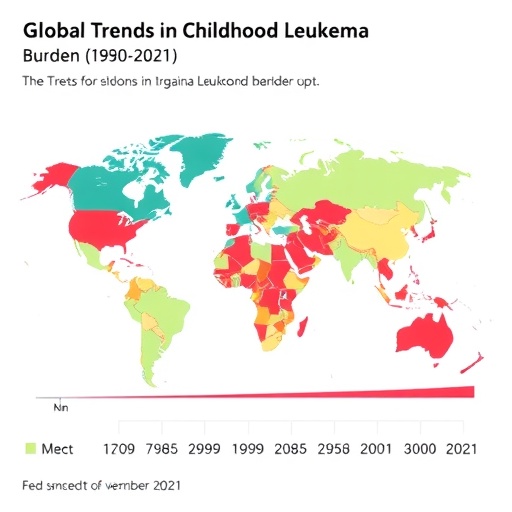In a pivotal study shedding light on childhood leukemia, researchers have meticulously tracked the global burden of this devastating disease from 1990 to 2021. Childhood leukemia remains one of the most prevalent forms of cancer affecting children worldwide, characterized by the uncontrolled proliferation of blood cells. This condition not only impacts the young population but also heavily burdens families, healthcare systems, and societies at large. By leveraging extensive data and sophisticated analytical techniques, the study aims to offer insights that could inform interventions and guide public health policies aimed at reducing the incidence and improving outcomes for affected children.
The research provides a comprehensive cross-sectional analysis, utilizing robust datasets compiled from various health organizations and statistical databases. The top-level findings indicate an alarming upward trend in the incidence of childhood leukemia over the years, highlighting an urgent need for increased awareness and proactive measures. This emerging data set aligns with various hypotheses regarding environmental factors, genetic predisposition, and sociopolitical influences that may contribute to the rising rates of leukemia in children.
Concerningly, the analysis also reveals discrepancies in incidence and survival rates based on geographic and socioeconomic factors. Children from lower socioeconomic backgrounds are disproportionately affected, which raises important questions about equitable access to healthcare and treatment options. The implications of such disparities underscore the critical need for targeted interventions that take into account these socioeconomic determinants. Addressing these disparities not only enhances individual health outcomes but also contributes to the overall goal of reducing the global burden of childhood leukemia.
The researchers utilized advanced statistical models to better understand the impact of various factors influencing childhood leukemia incidence and survival. Among the key elements considered were environmental pollutants, genetic markers, and healthcare access. The study’s intricate design allows for a nuanced interpretation of how these variables interact and influence the risk of developing leukemia. Such insights could pave the way for novel preventive strategies and personalized treatments tailored to children’s unique vulnerabilities.
Moreover, the findings suggest a pressing need for heightened surveillance programs to monitor not just the incidence but also the progression and outcomes of childhood leukemia. Current surveillance mechanisms may not adequately capture the complexities of this disease, particularly in low- and middle-income countries where healthcare infrastructure may be insufficient. The research advocates for the integration of better reporting practices and the establishment of comprehensive registries to gather consistent and actionable data.
As the study delves deeper into long-term outcomes, it sheds light on survival rates and the quality of life for childhood leukemia survivors. Despite significant advances in treatment protocols, the long-term effects of therapy can lead to enduring health challenges that survivors face well into adulthood. This facet of childhood leukemia is often overlooked in discussions surrounding treatment success and disease management, yet it is vital for understanding the holistic impact of the disease on young lives.
In fine-tuning treatment approaches, the research emphasizes the need for multidisciplinary care teams that include pediatric oncologists, hematologists, mental health professionals, and nutritionists. This comprehensive approach caters to the complex needs of children battling leukemia, addressing not only the physical manifestations of the disease but also the psychological and nutritional support essential for recovery. The findings advocate for healthcare policies that empower such collaborative models in clinical settings.
Intriguingly, the study draws attention to the promise of innovations in treatment modalities and emerging therapies. Advances such as targeted therapies and immunotherapies have shown promise in treating various forms of leukemia, and the research posits that these are crucial avenues for future exploration. Encouragingly, the evidence points toward the potential for improved outcomes with therapies tailored to the specific genetic profiles of the leukemia. This precision medicine approach heralds a new era in the treatment landscape, where treatments are not just standardized but personalized.
Furthermore, the societal burden of childhood leukemia extends beyond immediate health concerns; it encompasses the emotional and financial toll on families. Parents often face significant emotional distress, which can lead to a ripple effect impacting family unity and mental health. Understanding the psychosocial dynamics at play is essential for developing comprehensive support systems for families navigating this challenging journey. Community-based support, access to counseling, and financial care assistance programs can help alleviate some of the burdens families face.
The study’s findings call for increased advocacy at local, national, and global levels to prioritize childhood leukemia on the public health agenda. A well-informed public can drive demand for resources dedicated to research, treatment access, and preventive interventions. Collaborative efforts among governments, non-profits, and healthcare organizations can create a powerful coalition aiming to mitigate the impact of childhood leukemia while fostering a future where fewer children are diagnosed with this form of cancer.
Amidst the challenges, the resilience of the childhood leukemia community offers a glimmer of hope. Survivors and families often become advocates, utilizing their experiences to raise awareness and drive fundraising initiatives for research and treatment options. This empowerment can flourish into movements that not only provide hope to those currently battling the disease but also inspire future generations of researchers and healthcare professionals committed to eradicating childhood leukemia.
Ultimately, this study encapsulates a call to action for all stakeholders involved in tackling childhood leukemia. From researchers and clinicians to policymakers and advocates, collectively harnessing the insights generated can lead to transformative changes in how this disease is perceived and treated. The burden of childhood leukemia is indeed heavy, but with concerted efforts and unwavering commitment, a future with reduced incidence and improved survival rates may very well be within reach.
The path ahead involves ongoing research that builds on these findings, exploring various dimensions of childhood leukemia, including lifestyle factors, genetic research, and psychosocial support systems. Future studies should embrace interdisciplinary approaches, fostering collaboration across various fields to ensure that no facet of childhood leukemia is overlooked. With each study, we inch closer to unveiling the complexities of this disease and ultimately bringing hope to families around the world.
The insights from Wang et al.’s research encapsulate the global status of childhood leukemia, offering a thorough perspective that urges swift action. The urgent call for awareness, preventative measures, and equitable treatment signifies a crucial moment in the fight against pediatric cancers. It is within this collective effort and shared commitment that we can hope to redefine the narrative surrounding childhood leukemia and inspire a future where children can thrive beyond their diagnosis.
Subject of Research: Childhood leukemia global burden analysis from 1990 to 2021
Article Title: A cross-sectional analysis of the global burden of childhood leukemia from 1990 to 2021
Article References:
Wang, P., Cui, J., Ni, Z. et al. A cross-sectional analysis of the global burden of childhood leukemia from 1990 to 2021. J Cancer Res Clin Oncol 151, 295 (2025). https://doi.org/10.1007/s00432-025-06247-1
Image Credits: AI Generated
DOI: 10.1007/s00432-025-06247-1
Keywords: Childhood leukemia, global burden, incidence, socioeconomic factors, treatment, precision medicine, multidisciplinary care, advocacy, survivors, psychosocial support.
Tags: childhood cancer statistics 1990-2021childhood leukemia awareness initiativescomprehensive leukemia research methodologiesdisparities in leukemia survival ratesenvironmental influences on childhood leukemiagenetic predisposition to childhood leukemiaglobal childhood leukemia trendsglobal health interventions for cancer in childrenhealthcare challenges in childhood leukemiaincreasing leukemia rates in childrenpublic health policies for childhood cancersocioeconomic factors in leukemia incidence





